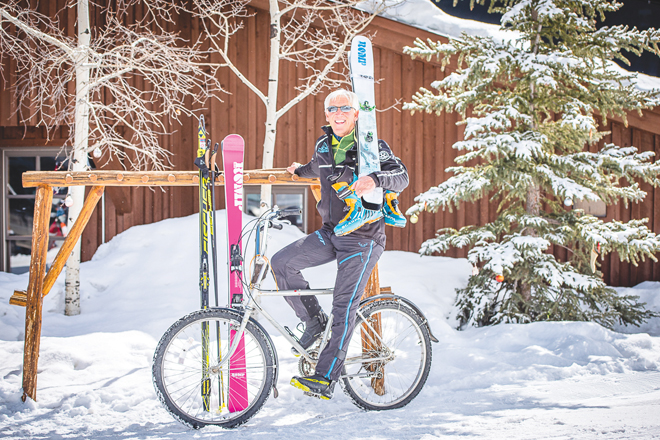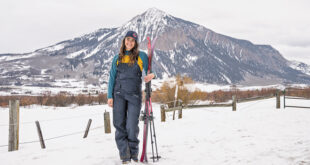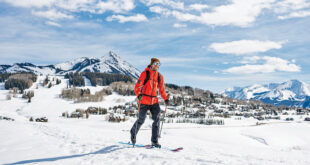Life Teacher
By Dawne Belloise
Although he taught physical education for decades, Murray Banks never wanted to be called “coach.” It was always Mr. Banks, because first and foremost, he was a teacher, an educator of life and a mentor to the many kids he guided through the various schools at which he taught in the northern New York/Vermont area. He was an avid athlete all through his youth and now, as a septuagenarian, enthusiastically skis, hikes and bikes and then hits a yoga class, sometimes mastering two or three activities from that list in one day.
Born and raised in Cortland in upstate New York, Murray was the eldest of four kids. His father was a mailman and his mother was an English teacher. Murray recalls, “We lived in a neighborhood, and the neighbor kids played outdoors all the time. We’d have a football game, or Whiffleball game, or we’d make a hockey rink in the winter.” He describes a gaggle of kids packing down the snow and maneuvering garden hoses to layer ice, saying, “Then we’d play yard hockey at night, taking the living room lamps and shining them out the window for light.”
All through his high school years, Murray played a variety of sports but found his success in running cross country and track. “It’s not a glamorous sport,” he grins. “The gun goes off and you run off into the woods and 20 minutes later you come back. No cheerleaders, no rallies, none of that stuff.”
He graduated from high school in 1965 with not a clue about what he wanted to do with his life, confessing, “I was not a good student. I couldn’t sit still. My learning style was by seeing and doing.” Nevertheless, he enrolled at Auburn Community College. He needed to get his GPA up and there was a really good coach there. “I wanted to go into forestry or be a game warden because I wanted to be outdoors in the woods,” he remembers. After two years, he transferred to State University of New York (SUNY) Cortland, where he made the dean’s list and won awards as an athlete. He graduated in 1969 with a bachelor of science degree in education.
“Eventually, I became a teacher,” Banks says, and his restlessness in class actually helped him in teaching. “I understood that not all children learn the same way. Most teaching is auditory but we know now that teachers who teach in a variety of ways capture the different learning styles of kids.”
Murray utilized that teaching method and had tremendous success with his innovative and creative style, which won him multiple awards throughout his career as an educator. “I tried to teach each child individually, not collectively.”
Murray left New York to teach a semester in Vermont but when a position opened in his hometown, he moved back to Cortland. “I just wanted to teach little kids. I wanted kids to come into my class and think it was so cool. I began to integrate math and spelling into my PE class,” he says. He’d chat with the other teachers about their curriculum so he could incorporate their week’s studies into his PE class. For example, if the math class was studying division, he’d ask his students to form in groups of 16 divided by four. It was a unique approach and Murray began getting requests to speak at conferences about the integration methods he was incorporating.
Murray met his wife, Janie, in college, both of them PE majors, and both stayed in Cortland, eventually earning their master of science degrees in education. They married in August 1970.
At the time, Murray felt that his hometown of Cortland wasn’t progressive—in fact, it was downright old-fashioned in its inhibitive teaching methods. “I didn’t feel that I had any colleagues I could bounce ideas off of. All the PE teachers had no interest in using progressive or innovative teaching techniques.” Consequently, he resigned. “I felt I’d reached the furthest point I could in that school district. I felt stifled. So Janie and I got out the map and said, where do we want to live?”
They determined they wanted to live in the mountains, and although they initially figured Colorado or Montana would be the place, Murray took a job opportunity in Bethel, Vermont, which wasn’t entirely foreign to them.
“Janie had grown up vacationing on her family’s tiny island on a lake in Vermont, so we were familiar with Vermont. Bethel was a very poor rural school district. I was the only PE teacher for K through 12. I was the head of the department because I was the department,” he smiles. “I thought, if I’m the only one teaching, I can do anything I want. I had to take a huge cut in pay but the community was beautiful. The mountain ridgelines came right down to the valley and the two branches of the White River.”
However, it was a really different community, Murray says, and the transition was difficult. “Cortland, as a university town, at least had a high value for education and teachers were paid really well, and we moved to this blue-collar community of loggers, farmers, contractors, and a little factory. It was 20 miles to Killington ski area. Three or four months in, I felt that I had made the wrong decision. The first six months were brutal and I started sending my résumé out. We had two little kids. Jeff was born in 1974 and Steve came along in ‘76, and through our sons, we began to meet other people our age with kids. We bought a big, drafty New England house with a big barn. We heated that house with about ten cords of wood a year. When the boys started school, we rode our bikes to school every day.”
His success in Cortland led to track meets named for him, (Murray Banks Invitational), but in Vermont, he lamented, “I’m coaching a losing team, they don’t value education, and we ran out of firewood.” And that’s when things began to turn around, he says. “Here’s my basketball team and all their dads delivering five cords of wood, in six pickup trucks.” Having lost 14 out of 17 games, he began offering summer basketball camps. The following two years they took State. “We got a big parade through town and all the fire engines lined up.”
Murray didn’t like being in a gym in the winter, so he set up an elective program where, he laughs, “These redneck kids were doing yoga, canoeing, cross country skiing, and aerobic dance.” He gave them 30 electives to choose from and called it Lifetime Fitness.
“I didn’t want to be the typical jock coach. I didn’t like the dumb jock connotation,” he says of requesting that his students not call him coach. “Teaching was my priority, not coaching. You turn out champions when you’re a really good teacher. Coaching, to me, is a very intimate form of teaching. They don’t dictate, they don’t teach generically, they teach precisely.” They stayed in Bethel for eight years.
The family would spend their summers on Hortonia, Janie’s childhood vacation island home and during that time, in the midst of all the teaching and coaching, Murray got back into running marathons. “Triathlons had just come into awareness. Every day I’d swim a half-mile to shore, run ten miles and swim back. A friend lent me his bike to do a triathlon, which I won and thought, this is a cool sport.”
He went on to win the half-Ironman in 1983 and landed an all-expenses-paid trip to Hawaii to compete in the full Ironman. His school backed him completely, changing his schedule around his necessary training and even continued to pay him while he was competing. His colleagues chipped in, donating their allotted days off to pay for his two-week absence. “My first goal was to finish and not be last,” he says of the grueling triathlon. “I had eight weeks to prepare.” Murray finished 42nd out of 1,200, and he humbly reflects, “It was the race of my life.”
Murray wanted to advance and get his doctorate in education, so he took a sabbatical for a year. Invitations to give talks about motivation and attitude from all over New England began rolling in. He realized that he could make as much income giving these lectures as he could teaching. During his sabbatical, he was a full-time athlete, intensively training to race triathlons, while giving his motivational talks and taking courses for his Ph.D.
By the end of his sabbatical, he had won the national championship triathlon and qualified to go back to the world championship Ironman in Hawaii, which consisted of a 2.5-mile swim, 112 miles on a bike and a 26-mile marathon to finish. “You stop doing everything else in your life and train twice a day, every day. I had just won teacher of the year in Vermont and the Outstanding Educator award, went to the Ironman in 1982-83 and now, people wanted me to come to their school and present a motivational talk to both the teachers and kids.”
He created a 40-minute presentation on having a positive attitude and a healthy lifestyle. “The story about going to the Ironman was just the vehicle to inspire kids to overcome obstacles and live a healthy lifestyle. Since 1984, my work has been solely giving speeches, flying all over the country, mostly to corporate groups and professional development for teachers.”
Murray and Janie discovered the Gunnison Valley when their youngest son, Steve, started college at Western State (now Western Colorado University). Then, their eldest son, Jeff, came to Crested Butte and never left. Inevitably, Murray and Janie stayed for longer visits each year.
Although they told their sons they’d never leave Vermont, that changed when their granddaughter, Winter, was born in February 2013. The following year, they made the move west with an additional game changer influencing their decision. Murray explains, “I had gotten diagnosed with prostate cancer. The prognosis isn’t very good,” he says, matter-of-factly, but with a smile. “So we bought the house on the corner of Third and Whiterock, and we couldn’t possibly love it more.”
At Dana Farber Cancer Institute in Boston Murray gets world-class treatment and what he describes as “Crested Butte love.” His attitude about facing both life and death is a powerful and inspirational message, one that he’s utilized in teaching and competing. His outlook exemplifies his beliefs and experiences and is reflected in his talks about motivation and positivity. “I’ve had a really good life. A lot of great things came my way. So I’m not fearful,” he says, and adds encouragingly, “There are treatments in the pipeline, like immunotherapy. It’s all coming, it’s being developed.”
Like his Crested Butte buddies, he’s über-active in outdoor sports but he does get slowed down a bit by the medications. He recalls his friends’ reactions. “Here’s where Crested Butte comes into that—all my friends are super fit and most are younger. Once I went on treatments, I starting declining invitations to go riding or skiing because I couldn’t keep up. These guys are typical Buttians—they really get after it. I was embarrassed, humiliated because after having done Ironman now I couldn’t keep up, but my friends were very insistent. One of my dearest friends said, ‘You waited for us for years, we can wait for you.’ That’s Crested Butte, so Crested Butte.”
“I don’t have cancer when I’m with my buddies, when I’m skiing, or when I’m with Winter. You don’t have to stop living when you have a dire prognosis. When you hear the C word and get a prognosis that isn’t good, you think ‘Oh my God, I’m dying,’ so I wanted my story to be how you can be living fully. If you live in a place like Crested Butte it’s a lot easier to deal with a prognosis like mine because this town is just so full of love. It’s incredibly supportive. It’s just the perfect place to be.”
Murray volunteers with Living Journeys. “I have a skill set I can lend to them, teaching inspiration, helping others.” He also volunteers at the Nordic Center coaching children and a master’s program for adults. “I just do what I do. I coach. You give and you get back. The other day I skied with the children and it knocks 40 years off my chronological age. You immerse yourself in playing games with kids on skis and it makes you feel young and alive.”
Murray and Janie have made Crested Butte home, and say, “We just love this town and the people. We have so many friends and they’re all active, cheerful, positive people. You bike down the street and you have to wave constantly. Even when we’re Nordic skiing on the trails, we have to stop and chat because you see everyone. Working in the yard takes two hours to get one hour of work done because you have to chitchat with everyone who comes by. If you had told me I’d love living in town, after living on a dirt road in the country in Vermont, I would have said you were crazy. Now I can’t imagine not living here.”
 The Crested Butte News Serving the Gunnison Valley since 1999
The Crested Butte News Serving the Gunnison Valley since 1999





